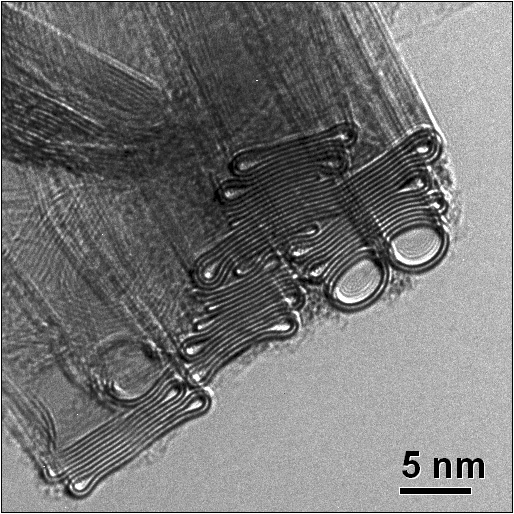Carbon nanotubes have become iconic symbols of nanotechnology, promising dramatic new breakthroughs in molecular electronics and holding out the possibility of transformational applications like the space elevator. Another perspective on these materials places them, not as a transformational new technology, but as the continuation of incremental progress in the field of high performance engineering fibres. This perhaps is a less dramatic way of positioning this emerging technology, but it may be more likely to bring economic returns in the short term and thus keep the field moving. A perspective article in the current issue of Science magazine – Making strong fibres (subscription required), by Han Gi Chae and Satish Kumar from Georgia Tech, nicely sets current achievements in developing carbon nanotube based fibres in the context of presently available high strength, high stiffness fibres such as Kevlar, Dyneema, and carbon fibres.
The basic idea underlying all these fibres is the same, and is easy to understand. Carbon-carbon covalent bonds are very strong, so if you can arrange in a fibre made from a long-chain molecule that all the molecules are aligned along the axis of the fibre, then you should end up pulling directly on the very strong carbon-carbon bonds. Kevlar is spun from a liquid crystal precursor, in which its long, rather rigid molecules spontaneously line up like pencils in a case, while Dyneema is made from very long polyethylene molecules that are physically pulled out straight during the spinning process. Carbon fibres are typically made by making a highly aligned fibre from a polymer like polyacrylonitrile, that is then charred to leave graphitic carbon in the form of bundles of sheets, like a rolled up newspaper. If you could make a perfect bundle of carbon nanotubes, all aligned along the direction of the fibre, it would be almost identical to a carbon fibre chemically, but with a state of much greater structural perfection. This idea of structural perfection is crucial. The stiffness of a material pretty much directly reflects the strength of the covalent bonds that make it up, but strength is actually a lot more complicated. In fact, what one needs to explain about most materials is not why they are as strong as they are, but why they are so weak. It is all the defects in materials – and the weak spots they lead to – which mean they rarely get even close to their ideal theoretical values. Carbon nanotubes are no different, so the projections of ultra-high strength that underlie ideas like the space elevator are still a long way off when it comes to practical fibres in real life.
But maybe we shouldn’t be disappointed by the failure of nanotubes (so far) to live up to these very high expectations, but instead compare them to existing strong fibres. This has been the approach of Cambridge’s Alan Windle, whose group probably is as far ahead as anyone in developing a practical process for making useful nanotube fibres. Their experimental rig (see this recent BBC news report for a nice description, with videos) draws a fibre out from a chemical vapour deposition furnace, essentially pulling out smoke. The resulting nanotubes are far from being the perfect tubes of the typical computer visualisation, typically looking more like dog-bones than perfect cylinders (see picture below). Their strength is a long way below the ideal values – but it is still 2.5 times greater than the strongest currently available fibres. They are very tough, as well, suggesting that early applications might be in things like bullet proof vests and flak jackets, for which, sadly, there seems to be growing demand. Another interesting early application of nanotubes highlighted by the Science article is as processing aids for conventional carbon fibres, where it seems that the addition of only 1% of carbon nanotubes to the precursor fibre can increase the strength of the resulting carbon fibre by 64%.

“Dogbone” carbon nanotubes produced by drawing from a CVD furnace. Transmission electron micrograph by Marcelo Motta, from the Cambridge research group of Alan Windle. First published in M. Motta et al. “High Performance Fibres from ‘Dog-Bone’ Carbon Nanotubes”. Advanced Materials, 19, 3721-3726, 2007.
My CNT news byte of the year is using thermal decomposition (which I think is just a fancy chemistry way of saying heating) at about 400C to turn ordinary resins into CNT products:
http://www.sciencedaily.com/releases/2008/02/080207153618.htm
The products are bulkier and thus more limited than what could be customized from fibres or individual CNTs. I appreciate how important to global industry, USA DoD research is; hope R+D funding levels are maintained under any economic climate.
Very nice article ! However, please correct the caption of the image above. The image was taken by “Marcelo Motta” not “Juan Vilatela”.
This image was first published in:
M. Motta et al. “High Performance Fibres from ‘Dog-Bone’ Carbon Nanotubes”. Advanced Materials, 19, 3721-3726, 2007.
Correction made – my apologies, Marcelo.